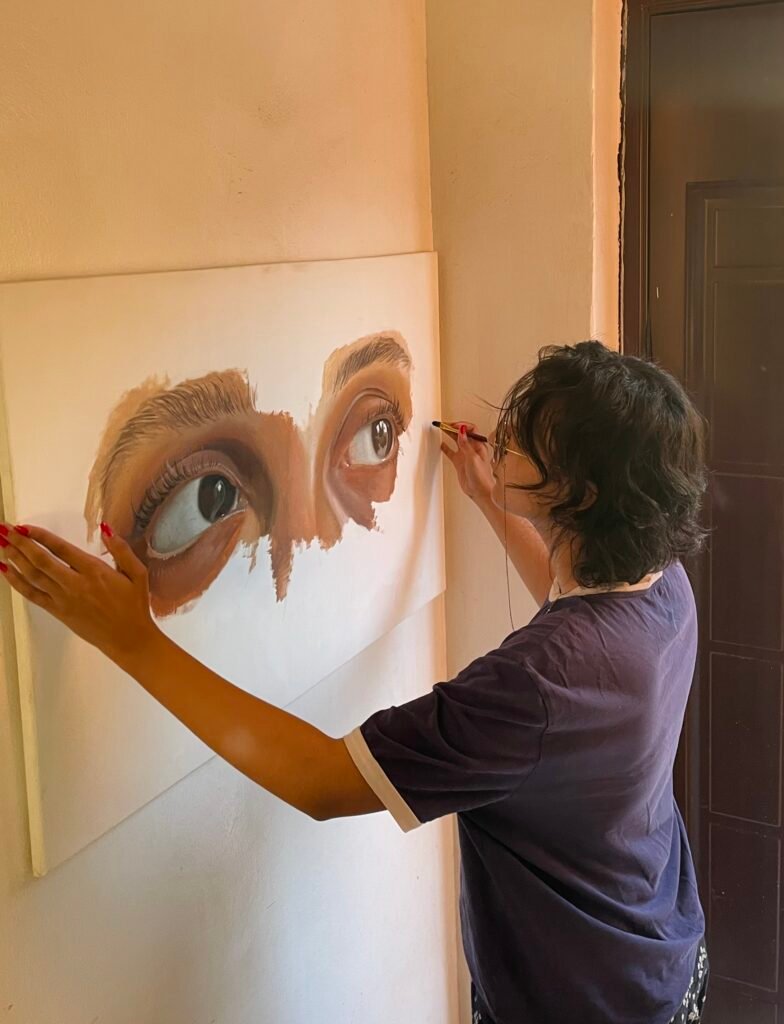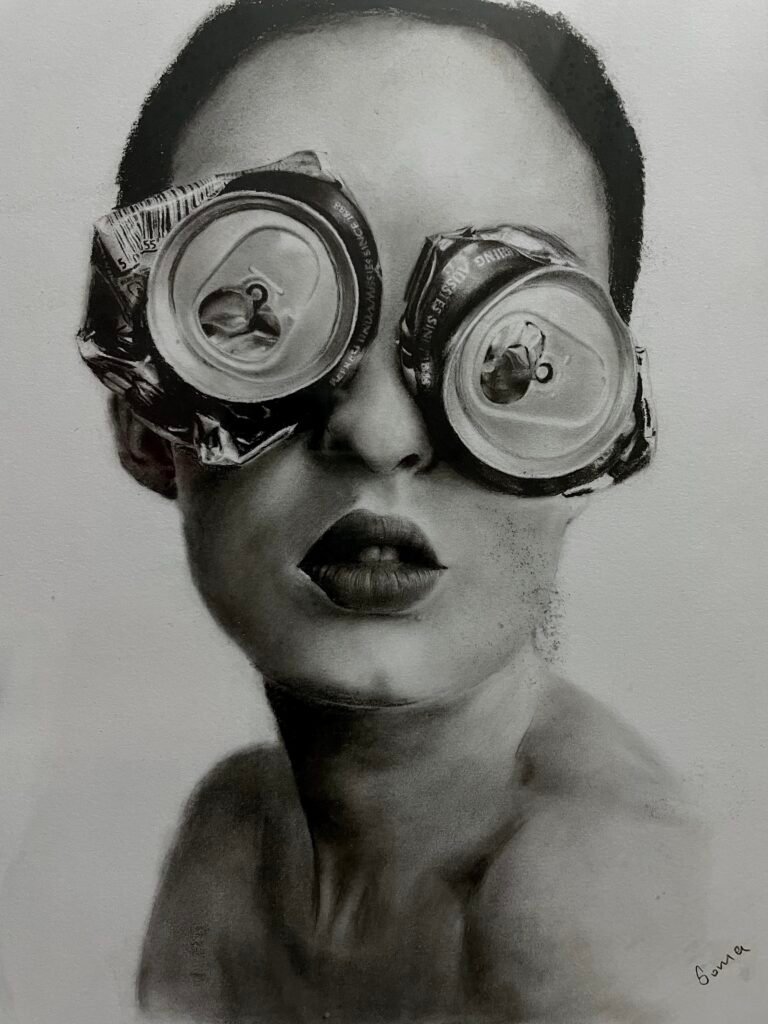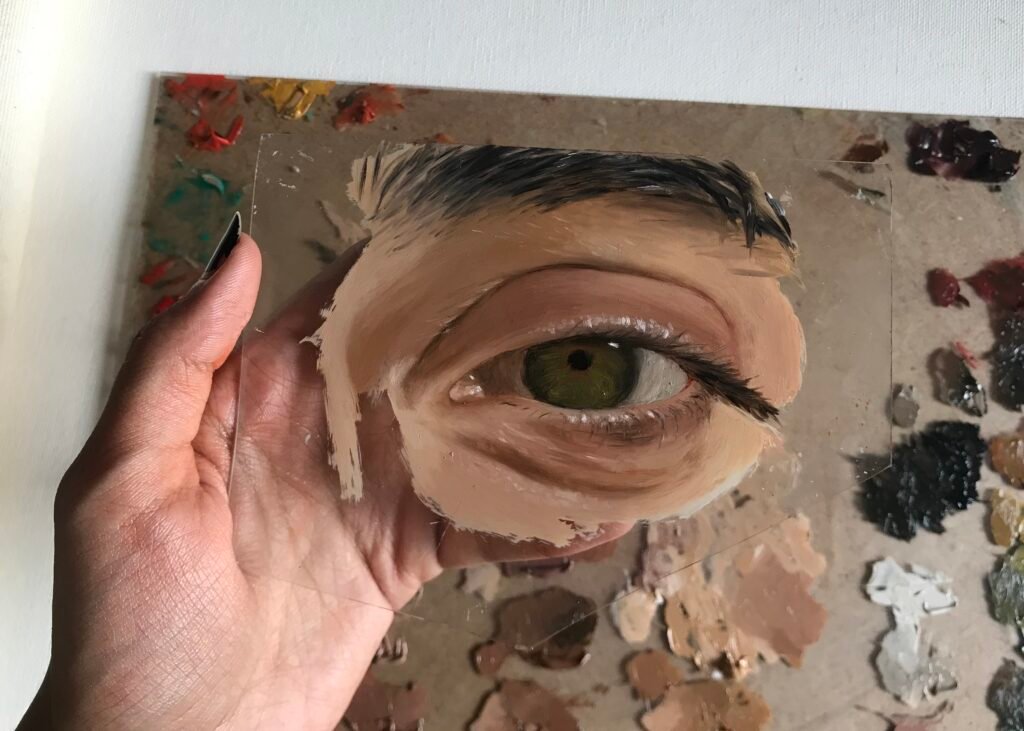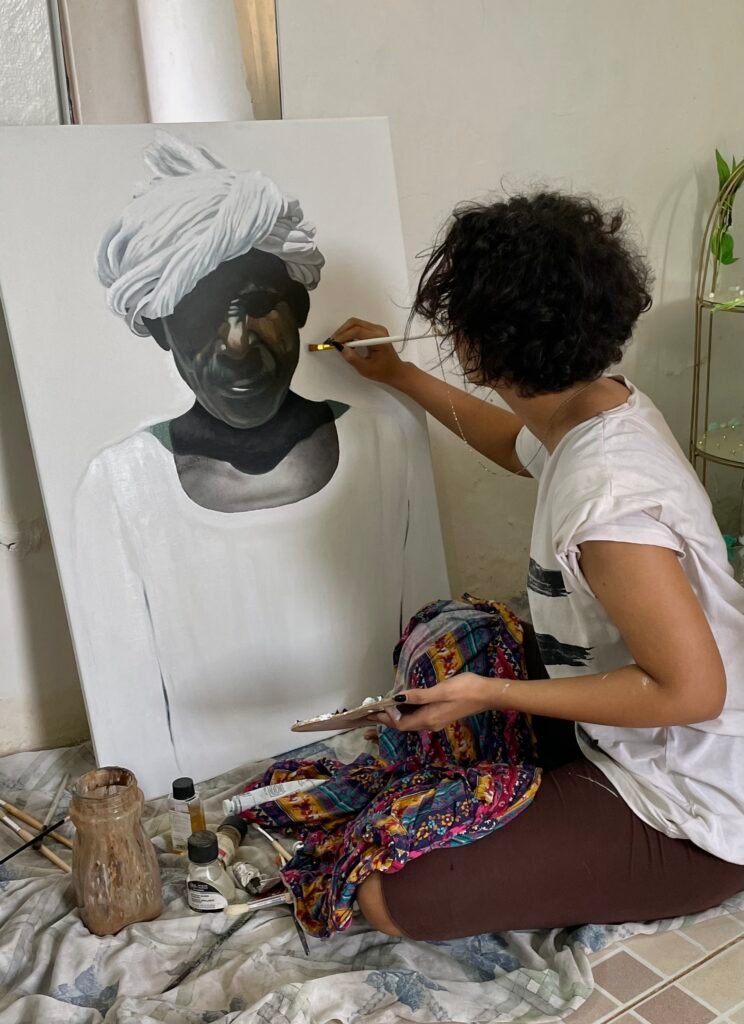Interview by Renad Abdelhakam
هذه المقالة متوفرة باللغة العربية بالأسفل

Asma Siddig is a talented Sudanese artist who has captured the hearts of many with her beautiful and thought-provoking paintings. Her unique style and use of vibrant colours have garnered widespread attention, but what sets her apart is her ability to bring to life human emotions and struggles through her art. In this interview, we get a chance to delve deeper into the mind of this incredible artist and learn more about her artistic journey, inspirations, and hopes for the future.
Q:
Asma, how did you transition from black and white pencil sketches to vibrant oil paintings? What or who has been your biggest inspiration in this transition?
A:
From the beginning of my journey, I was really mesmerised by oil painting; the texture and colours really brought so much joy to me, but I had to start with the basics. I had a very classical approach when it came to Art, as I had to go through the A B C’s of learning about shapes and elements of an art piece and the vision tricks and to do so, you must start with the simplest tool, which is the pencil. I then gradually added charcoal to explore more options and add more depth to my drawings. At that point, I was afraid to start with oil painting because I thought of all the endless possibilities it brings, but the fact that I built a solid ground to start with made it easier than I expected. Until this moment, I’m still exploring more every time I start a painting.
My biggest inspiration was the Swedish artist Miles Johnston (who works primarily in graphite and oils). He had a similar approach and always talked about the benefits of starting your way by sketching as much as possible.


Q:
“From your initial black and white pencil drawings to exploring oils, charcoal, and even digital art, how have different mediums shaped your artistic expression? Could you tell us about an artwork or a project that was a significant learning experience for you, and Are there any new techniques or styles you are eager to explore in the future?”
A:
Different tools bring different outcomes. It’s very interesting that if you try to draw/paint the same thing multiple times with different tools, each one will have a totally different personality, so yes, it’s something everyone should try. It’ll help you to decide before you start on which medium you should go with.
Painting eyes is very important to me, not just because I love it so much but also because it’s a good practice; it can include all the shapes and colours in one small piece. I’d love to try everything, to be honest, and especially Impressionism.


Q:
Artists often have rituals to help them create a good atmosphere to work; how does your environment affect your process?
A:
The atmosphere just comes on its own; some days, you’re painting, and you’re in a relaxed mood, and you just chill and listen to your favourite song and enjoy your time. Other days, you just paint your feelings away when you feel the urge to do something about it; it can be very chaotic sometimes, so it brings a messy atmosphere with it.

Q:
Your paintings, especially those reflecting the current situation in Sudan and the revolution, carry powerful messages. What motivates you to incorporate these themes into your art, and how do you hope your work impacts viewers, particularly in light of the recent events in Sudan?
A:
Whenever the situation in Sudan is far from okay, it’s very hard to think of anything else as it is all a big part of our lives. Yet, I am not painting to bring light to the situation or to carry any messages; I’m only trying to express our reality, hoping we can find comfort around it. I think we suffer more when we’re trying to proceed with our lives without taking a minute to sit and realise that what happened is not okay, and we all feel the same way about it.


Q:
Looking back on your artistic journey, what is one piece of advice that has significantly helped you, and what advice would you give to your past self or other aspiring artists?
A:
DRAW/PAINT AS MUCH AS YOU CAN.

Q:
“From your experience as a woman in the art world, what do you feel is essential for the support and growth of female artists, especially in contexts like Sudan? How can initiatives like Bait Alnisa contribute more effectively?”
A:
As Sudanese women, we don’t get a lot of opportunities to explore more, and we have more restrictions in our journey, which can limit our perspective. As artists, we need to SEE more in life to make more art. But we also have our unique experience, the mere experience of being Sudanese women, which also gives us a lot to talk about. I think we all just end up finding a way to turn the negative into a positive.
We all need support and some encouragement from time to time. Bait Alnisa can positively impact female artists by bringing more attention to all female artists by supporting their journey and celebrating each milestone, and it has already made a positive impact on all.

من دفتر الرسم إلى اللوحة: التطور الفني لأسماء صديق
مقابلة بواسطة رناد عبدالحكم

أسماء صديق، فنانة سودانية موهوبة استطاعت أن تأسر قلوب الكثيرين بلوحاتها الجميلة والملهمة. أسلوبها الفريد واستخدامها لألوان زاهية جذبت انتباه الجميع، ولكن ما يميزها هو قدرتها على إحياء المشاعر الإنسانية وإظهار الصراعات من خلال فنها. في هذا اللقاء، سنحظى بفرصة للغوص في عقل هذه الفنانة المذهلة، ونتعرف أكثر على رحلتها الفنية ومصدر إلهامها وآمالها للمستقبل.
س:
أسماء، انتقالك من الرسومات بقلم الرصاص إلى لوحات الزيت تغيير ملحوظ للغاية. هل يمكنك مشاركتنا ما الذي جذبك في البداية إلى عالم الفن؟ وبشكل خاص إلى الواقعية التي تميز أعمالك؟ كيف تحول عملك من الرسومات بالأسود والأبيض إلى لوحات زيتية حية؟ من هو أو ما هو مصدر إلهامك الأكبر في هذا التحول؟
ج:
منذ بداية رحلتي، كنت مفتونة بالرسم بالألوان الزيتية؛ فالملمس الذي تنتجه والألوان تجلبان لي الكثير من الفرح. ولكن كان عليَّ أن أبدأ من الصفر؛ كان لدي نهج كلاسيكي جدًا فيما يتعلق بالفن؛ كان عليَّ أن أمراً بأساسيات تعلم الأشكال وعناصر اللوحة وحيل الرؤية، وللقيام بذلك يجب أن تبدأ بأبسط الأدوات وهي الأقلام، ثم أضفت تدريجيًا الفحم لاستكشاف المزيد من الخيارات وإضافة المزيد من العمق إلى رسوماتي. في ذلك الوقت، كنت خائفة من بدء تعلم الرسم بالألوان الزيتية؛ لأنني فكرت في كل الإمكانيات اللامتناهية التي تجلبها، لكن الحقيقة أنني بنيت أساسًا قويًا جعل البدأ بالالوان الزيتية أسهل مما توقعت.
حتى هذه اللحظة، ما زلت أستكشف المزيد في كل مرة أبدأ فيها لوحة. أكبر مصدر إلهام لي كان الفنان السويدي مايلز جونستون (يرتكز عمله على الرصاص وألوان الزيت). كان لديه نهج مماثل، حيث دائمًا يتحدث عن فوائد بدء طريقك من خلال الرسومات.


س:
من رسوماتك الأولية بأقلام الرصاص إلى اسكتشاف الالوان الزيتية والفحم، وحتى الفن الرقمي، كيف شكلت الوسائط المختلفة تعبيرك الفني؟ هل يمكنك أن تحدثينا عن عمل فني أو مشروع كان تجربة تعلم مهمة بالنسبة لك؟ وهل هناك تقنيات أو أساليب جديدة تأملين استكشافها في المستقبل؟
ج:
الأدوات المختلفة تجلب نتائج مختلفة. من المثير للاهتمام جدًا أنه إذا حاولت رسم الشيء نفسه مرات عديدة باستخدام أدوات مختلفة، فإن كل واحدة ستكون لها شخصية مختلفة تمامًا، لذا نعم، هذا شيء يجب على الجميع تجربته. سيساعدك ذلك في اتخاذ القرار عند البدء لتقرر أي خامة يجب أن تستخدم.
رسم العيون مهم جدًا بالنسبة لي ليس فقط لأنني أحبه كثيرًا، ولكن أيضًا لأنه تمرين جيد، حيث يمكن أن يشمل جميع الأشكال والألوان في قطعة صغيرة واحدة. أود أن أجرب كل شيء بصدق وخصوصًا أسلوب الانطباعية.


س:
الفنانون غالباً يملكون طقوسًا لمساعدتهم على خلق جو جيد للعمل؛ كيف تؤثر بيئتك على عمليتك الإبداعية؟
ج:
الأجواء تأتي بشكل طبيعي، في بعض الأيام، ترسم في مزاج مسترخٍ، وتستمتع بأغنيتك المفضلة، وتقضي وقتًا ممتعًا. في أيام أخرى، ترسم مشاعرك عندما تشعر بالرغبة في القيام بشيء حيالها؛ يمكن أن تكون فوضوية جدًا في بعض الأحيان، لذلك تجلب معها أجواء فوضوية.

س:
رسوماتك، خاصة تلك التي تعكس الوضع في السودان والثورة السودانية، تحمل رسائل قوية. ما الذي يحفزك على دمج هذه الثيمات في فنك، وكيف تأملين أن يؤثر عملك على المشاهدين، خاصة في ظل الأحداث الأخيرة في السودان من حرب؟
ج:
كل ما يحدث هو جزء كبير من حياتنا، وكلما كانت الحالة في السودان بعيدة عن الاستقرار، كان من الصعب جدًا التفكير في أي شيء آخر. ولكنني لا أرسم لإلقاء الضوء على الحالة أو لنقل أي رسائل. أحاول التعبير عن واقعنا، على أمل أن نستطيع العثور على الراحة حولنا. أعتقد أننا نعاني أكثر عندما نحاول مواصلة حياتنا دون أن نأخذ لحظة للجلوس والتفكير في أن ما حدث ليس بالأمر الهين، وأننا جميعًا نشعر بالطريقة نفسها تجاهه.


س:
عند النظر إلى رحلتك الفنية، ما هي النصيحة التي ساعدتك بشكل كبير، والتي تودين أن تقدميها لذاتك في الماضي أو لفنانات طموحات أخريات؟
ج:
النصيحة الوحيدة التي أستطيع تقديمها هي أن ارسمي قدر المستطاع.

س:
من خبرتك كامرأة في عالم الفن، ما هو الشيء الأساسي الذي تشعرين بأنه ضروري لدعم ونمو الفنانات، خاصة في سياقات مثل السودان؟ كيف يمكن لمبادرات مثل بيت النسا المساهمة بشكل أكثر فعالية؟
ج:
كنساء سودانيات لا نحصل على الكثير من الفرص لاستكشاف المزيد، ولدينا قيود أكثر في رحلتنا التي يمكن أن تحد من آفاقنا وكفاءتنا كفنانات. ولكن لدينا أيضًا تجربتنا الفريدة، تجربة كوننا نساء سودانيات، والتي تمنحنا الكثير للحديث عنه. أعتقد أننا جميعًا نجد طريقة لتحويل السلبيات إلى إيجابيات.
نحتاج جميعًا إلى الدعم والتشجيع من حين لآخر. يمكن لبيت النساء أن يؤثر في نحو إيجابي على الفنانات بجلب اهتمام أكبر لجميع الفنانات ودعم رحلتهن والاحتفال بكل إنجاز، وقد أحدث تأثيرًا إيجابيًا بالفعل على الجميع.



Leave a Reply
You must be logged in to post a comment.